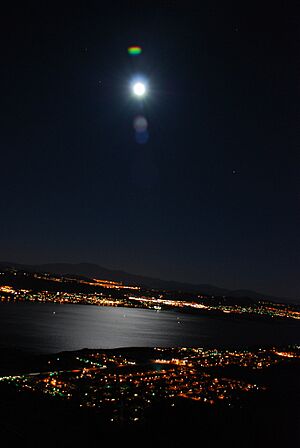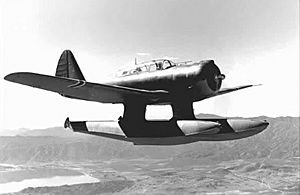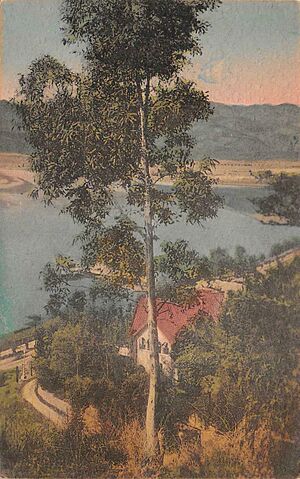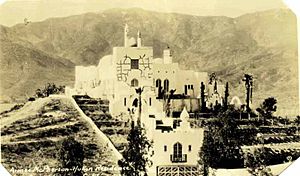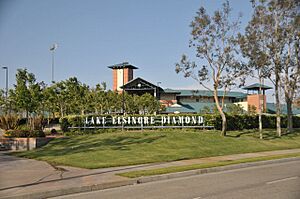Lake Elsinore, California facts for kids
Quick facts for kids
City of Lake Elsinore
|
||
|---|---|---|
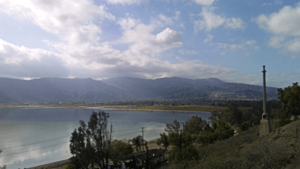
View of Lake Elsinore
|
||
|
||
| Motto(s):
"Dream Extreme"
|
||
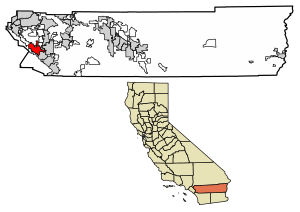
Location of Lake Elsinore in Riverside County, California
|
||
| Country | United States | |
| State | California | |
| County | ||
| Incorporated | April 9, 1888 | |
| Government | ||
| • Type | Council-Manager | |
| Area | ||
| • Total | 43.51 sq mi (112.70 km2) | |
| • Land | 38.24 sq mi (99.03 km2) | |
| • Water | 5.28 sq mi (13.67 km2) 13.14% | |
| Elevation | 1,296 ft (395 m) | |
| Population
(2020)
|
||
| • Total | 70,265 | |
| • Estimate
(2022)
|
71,898 | |
| • Density | 1,880.18/sq mi (726.02/km2) | |
| Time zone | UTC−8 (PST) | |
| • Summer (DST) | UTC−7 (PDT) | |
| ZIP Codes |
92530–92532
|
|
| Area code | 951 | |
| FIPS code | 06-39486 | |
| GNIS feature IDs | 1652704, 2411601 | |
Lake Elsinore is a city in Riverside County, California. It's located right on the shore of Lake Elsinore, a large natural freshwater lake. The city was officially started in 1888.
For many years, Lake Elsinore was a small resort town. People came to enjoy the lake and its natural springs. Today, it has grown into a busy suburban city with over 70,000 residents.
History of Lake Elsinore
The area around Lake Elsinore has a long history. Native American groups, like the Luiseño people, lived here first. You can still find their ancient pictographs (rock paintings) in the nearby mountains.
The lake was first seen by Spanish explorers in 1797. At that time, it was called Laguna Grande. In the early 1800s, the lake grew larger. It became a popular stop for travelers, including those on the California Gold Rush trail.
In 1844, a large piece of land, including the lake, became a ranch called Rancho La Laguna. An adobe house was built there. Later, this ranch became a stop for the Butterfield Overland Mail, which delivered mail across the country.
The lake's water levels changed a lot over the years. Sometimes it was very full, like after the Great Flood of 1862. Other times, it almost dried up during droughts.
In 1883, a group of people bought the ranch land. They wanted to start a new town. In 1884, a railroad line was built nearby, which helped the town grow. On April 9, 1888, Elsinore officially became a city. It was named after a Danish city, Helsingør, which is famous from William Shakespeare's play Hamlet. Today, Helsingør is a sister city to Lake Elsinore.
In the late 1800s, people discovered mineral springs near the lake. These springs attracted visitors looking for health treatments. A famous bathhouse, "The Chimes," was built in 1887 and is still standing. The city's economy also relied on coal and clay mining, gold mining, and farming.
Lake Elsinore became a popular getaway for Hollywood celebrities in the early 1900s. Many built homes there. One famous home is Aimee's Castle, built by evangelist Aimee Semple McPherson. Actor Bela Lugosi, known for playing Dracula, also had a home in the city.
The city was described in 1919 as a delightful place with good schools and a healthy climate. It even had its own sewer system and paved streets.
The lake was used for Olympic training and high-speed boat races in the 1920s. During World War II, seaplanes were tested on the lake, and a factory in the city made parts for bombers.
In 1972, the city's name was changed to Lake Elsinore. In 1980, heavy rains caused the lake to flood. Since then, a big project has helped keep the lake's water level steady. This allows homes and businesses to be built safely near the water.
Lake Elsinore has grown quickly. Between 2000 and 2008, it was the 12th fastest-growing city in California.
Geography and Climate
Lake Elsinore covers about 43.5 square miles (112.7 square kilometers). About 13% of this area is water, thanks to the lake itself.
Lake Elsinore is the biggest natural freshwater lake in Southern California. It's at the lowest point of the San Jacinto River watershed. This means water from a large surrounding area flows into the lake. The lake's water level can change, but efforts are made to keep it from drying up or flooding. When the lake gets too full, water flows out through Temescal Wash, which eventually reaches the Santa Ana River and then the Pacific Ocean.
The city is surrounded by mountains. To the west are the Elsinore Mountains, part of the Santa Ana Mountains. These mountains sometimes get a little snow. To the east are the older Temescal Mountains.
City Districts
Lake Elsinore is divided into 11 districts. Each district has its own unique features, history, and feel. These districts include Alberhill, Ballpark, Business, Country Club Heights, East Lake, Historic, Lake Edge, Lake Elsinore Hills, Lake View, North Peak, and Riverview.
Alberhill District
The Alberhill District has rolling hills and open land. It's known for its long history of mining, especially for clay and coal. Mining operations started here in the 1880s when the first railroad was built. Today, Pacific Clay Products Company is the main clay mine in the area.
Ballpark District
This district is named after the Lake Elsinore Diamond Stadium. This stadium is home to the Lake Elsinore Storm professional baseball team, which is part of the San Diego Padres. The area used to have the city's first train station.
Business District
The Business District is a newer area with many stores and businesses. It has large retail stores, the Lake Elsinore Outlets, and marshlands. It's located near Interstate 15.
Country Club Heights
The Country Club Heights District is known for its steep hills and great views of the lake. It has a rich history, dating back to 1912. Two famous homes, the Schultz Mansion (now Bredlau Castle) and the Corlin Mansion, were built here in 1926. These homes were used for many social events.
Aimee Semple McPherson's famous home, "Aimee's Castle," is also in this district. It was built in 1928 with a unique Moorish design. The International Church of the Foursquare Gospel now owns and cares for the property.
The Clevelin Country Club was once a major attraction here. It had a ballroom, banquet hall, and even secret tunnels. It closed during the Great Depression and later burned down in 2001.
East Lake District
The East Lake District is mostly flat and includes the Summerly neighborhood. Native Americans used parts of this area long ago. More recently, it's been popular for motocross, skydiving, and hang gliding. This district is close to the lake and has been affected by floods in the past. Projects are now in place to prevent future flooding.
Historic District
The Historic District has been the heart of Lake Elsinore since the city was founded in 1888. Many old buildings are here, including "The Chimes" bathhouse, the Chamber of Commerce (which used to be a train station), and the Cultural Center (a former church). The oldest neighborhoods and the downtown area are found here.
Lake Edge District
The Lake Edge District is right along the lake's shore. It has been important to Native Americans, early settlers, and visitors for centuries. It was once home to the Machado Adobe House, one of the city's oldest buildings, which was part of a stagecoach stop. Sadly, this building was destroyed by fire in 2017.
The former Elsinore Naval and Military School building, a historic structure, is also in this district. A new campground, marina, and boat launch are located on the northwest side of the lake.
Lake Elsinore Hills
The Lake Elsinore Hills District has a mix of flat areas, rolling hills, and steep slopes. Many parts are undeveloped due to the challenging terrain. It offers amazing views of Lake Elsinore and the Santa Ana Mountains. Neighborhoods here include Tuscany Hills, Canyon Hills, and Rosetta Canyon.
Lake View District
The Lake View District offers beautiful views of the lake and mountains, especially in its northwestern parts. Historically, this area was mostly undeveloped, except for some early neighborhoods. The railroad and mining opportunities brought people here in the late 1800s. Many lower-lying areas have recently been developed with single-family homes.
Riverview District
The Riverview District has both steep and flat areas. It's located between a hill and the San Jacinto River, which flows through the district and into Lake Elsinore. The higher parts of this district form a natural border with the Historic District.
Climate
Lake Elsinore has a mild, semi-dry climate. Summers are hot and mostly rainless, while winters are mild and wetter. The hottest month is usually July, and the coolest is December. The highest temperature ever recorded was 118°F (48°C) in August 1933. The lowest was 10°F (-12°C) in December 1974. Most rain falls in February, and very little in the summer months.
Population and Economy
Lake Elsinore has grown a lot over the years. In 1900, only 279 people lived here. By 2020, the population had grown to over 70,000 residents.
Shopping and Jobs
One of California's first outlet centers, the Outlets at Lake Elsinore, opened here in the late 1990s. It has many different stores, from clothing to electronics.
Pacific Clay is one of the companies based in Lake Elsinore.
The biggest employers in the city include:
- Lake Elsinore Unified School District (schools)
- M & M Framing
- Stater Bros. Markets (grocery store)
- Costco Wholesale (warehouse club)
- Walmart (retail store)
- Lake Elsinore Hotel & Casino
- Riverside County Department of Social Services
- Elsinore Valley Municipal Water District (EVMWD)
- The Home Depot (home improvement store)
- City of Lake Elsinore
Services and Transportation
Education
Most public schools in Lake Elsinore are part of the Lake Elsinore Unified School District. This district serves about 21,500 students. It has 15 elementary schools, five middle schools, and three high schools: Lakeside, Temescal Canyon, and Elsinore. There are also a few private schools in the city.
Libraries and Post Office
Lake Elsinore has two libraries: the Lake Elsinore Library and the Lakeside Library. Both are part of the Riverside County Library System. The United States Postal Service also has a post office in the city.
Cemeteries
The Elsinore Valley Cemetery District manages a public cemetery that was started in 1891. There's also a historic family cemetery, the Manker Family Cemetery, with burials from the late 1800s.
Roads and Highways
Interstate 15 is a major highway that runs through Lake Elsinore. It connects the city to places like San Diego to the south and Las Vegas to the north. State Route 74 connects Lake Elsinore to Orange County to the west and other cities to the east.
Many local streets also connect Lake Elsinore to nearby cities like Wildomar, Canyon Lake, and Menifee.
Public Transportation
The Riverside Transit Agency provides bus services in Lake Elsinore. They have several local and express bus routes for getting around the city and to other areas.
Sports and Recreation
Lake Elsinore Diamond
The Lake Elsinore Diamond is a baseball stadium. It's home to the Lake Elsinore Storm, a minor league baseball team that plays for the San Diego Padres. The stadium also hosts special events like concerts.
In 2012, the city planned a veterans memorial with a religious symbol. After a lawsuit, the design was changed to remove the religious symbols. The memorial, without religious symbols, was finally installed in 2014.
Elsinore Grand Prix
The Elsinore Grand Prix is a famous dirt-bike race held in and around Lake Elsinore. It usually happens in mid-November. In the late 1960s and early 1970s, famous riders like Malcolm Smith and Steve McQueen participated. The race is "open," meaning anyone can ride.
The race was stopped in the mid-1970s but was brought back in 1996. In 1973, Honda even named one of its motorcycles, the CR250M Elsinore, after this race. Lake Elsinore is also a popular spot for motorcyclists riding along the Ortega Highway.
Skateparks
Lake Elsinore has two skateparks for skateboarding enthusiasts. McVicker Canyon Park has the first city-owned skatepark. Serenity Park, built in 2015, features a peanut-shaped bowl, ramps, and quarter-pipes. It was designed by a well-known firm from Los Angeles.
Notable people
- Ally Beardsley, actor, comedian, and writer
See also
 In Spanish: Lake Elsinore para niños
In Spanish: Lake Elsinore para niños





